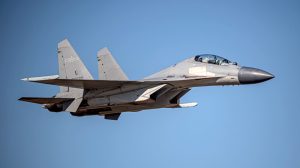The Diplomat author Mercy Kuo regularly engages subject-matter experts, policy practitioners, and strategic thinkers across the globe for their diverse insights into U.S. Asia policy. This conversation with Eric Chan ̶ a senior strategist at the United States Air Force and non-resident research fellow at the Global Taiwan Institute – is the 333rd in “The Trans-Pacific View Insight Series.” The views expressed in this interview are Chan’s own and are not intended to represent those of his affiliate organizations.
How did the visit of U.S. House Speaker Nancy Pelosi to Taiwan change the status quo in the U.S.-China-Taiwan dynamic?
I think we should be wary of the term “status quo.” Over the last few years, the PRC dramatically changed the status quo via gray zone warfare: hundreds of incursions in Taiwan’s Air Defense Identification Zone, sand dredging around Matsu, election meddling in Taiwan. The PRC has used Speaker Pelosi’s visit as an excuse to increase the scale of their coercion operations. The biggest difference is that Xi Jinping doesn’t feel the need to obfuscate his use of coercive power anymore.
Identify key shifts in China’s policy toward Taiwan and the United States.
There is a number of key shifts.
1989, post-Tiananmen: The CCP shifts its perception of highest threat from the USSR to the U.S.
1991, the Gulf War as well as the 1996 Third Taiwan Strait Crisis: The Chinese Communist Party [CCP] realizes that its primary guarantor of power, the PLA, would be powerless against American intervention.
1999, after the accidental U.S. bombing of the PRC Embassy in Belgrade: The CCP believes that it has no global tools to respond to perceived U.S. intimidation.
After Xi comes into power [in late 2012], he begins actively testing the boundaries for coercion.
2014, the Sunflower Movement in Taiwan: Xi finds out that economic carrots for unification have limited appeal for the Taiwan population.
2015, Xi reneges on his understanding with Obama of non-militarization in the South China Sea and cyber-theft: the PRC suffers no consequences from the United States.
2019-2020, the crushing of the anti-extradition law protests in Hong Kong: The PRC suffers no consequences from the global community, while Taiwan turns even more strongly against the PRC.
We’re undergoing a shift now. Xi is testing if enhanced coercion against Taiwan will be met with resistance.
Note that other than the Sunflower Movement and the crushing of the anti-extradition law protests in Hong Kong, the main driver of shifts in PRC policy towards Taiwan is largely due to CCP perceptions of U.S. strength and policies against the PRC.
Explain the implications of Taipei’s rejection of Beijing’s “One China, Two Systems” plan in China’s recent white paper.
The recent white paper actually watered down the existing “understandings” in One China, Two Systems – not that Xi was going to honor them anyway, as demonstrated by Hong Kong. It is clear that the party is not particularly interested in persuading the people of Taiwan. Taipei’s rejection was expected by the CCP and will set the stage for more comprehensive legal warfare in the upcoming Party Congress, likely via a strengthened anti-secession law. It is designed so that the party can then state a favored warning phrase: Don’t say we didn’t warn you!
Analyze how the heightened stakes for the U.S. military in escalating cross-strait tensions.
The U.S. military has several jobs in the Indo-Pacific. It must reassure partners and allies, while deterring adversaries. Sometimes there is tension between the two objectives. However, the PRC’s aggressive and disproportionate actions have reduced that particular concern. Instead, the main question is now how best the U.S. military can demonstrate deterrence in conjunction with allies and partners, to address both the prospect of an invasion as well as gray zone or salami-slicing tactics. The chances of tactical miscalculation by the PLA have decreased, but the chances of strategic miscalculation on part of party leadership have dramatically increased.
Assess the viability of Washington’s “strategic ambiguity” policy on cross-strait relations.
I believe “strategic ambiguity” is increasingly moribund for multiple reasons. First and foremost: Xi Jinping is not satisfied with PRC strategic patience, which was part of the context for U.S. strategic ambiguity. Second, Xi does not believe the U.S. is adhering to strategic ambiguity; rather, for him, it is strategic ambiguity in name only. Third, as the PRC has become more hawkish across the DIME [diplomatic, informational, military, and economic] spectrum against both Taiwan and the U.S., the U.S. government as a whole – and particularly Congress – has become significantly more sympathetic towards Taiwan. Fourth, U.S. strategic ambiguity is also meant to deter Taiwan from formally seeking independence. This is no longer relevant as the PLA is now fully capable of that deterrence.
As Xi will almost certainly continue his coercion and legal warfare campaign against Taiwan, the pressure against strategic ambiguity will continue to grow in the U.S., as evidenced by proposals like the Taiwan Policy Act.

































